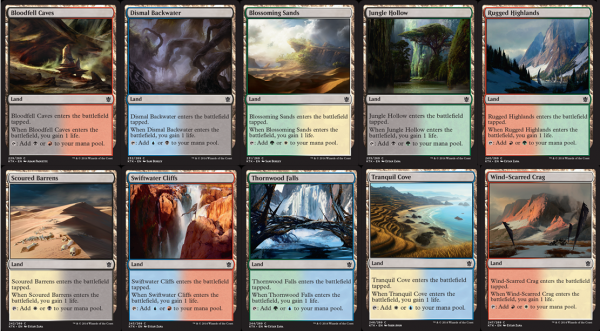Are you a Quiet Speculation member?
If not, now is a perfect time to join up! Our powerful tools, breaking-news analysis, and exclusive Discord channel will make sure you stay up to date and ahead of the curve.
When Vintage Masters hit Magic Online, I started playing a lot of sealed deck. So to help others in release events, I wrote a primer on sideboarding in sealed deck. In preparation for the Khans of Tarkir prerelease this weekend, I thought I’d share more sealed deck tips today. In honor of this multicolored set, I'll be focusing on the manabases.
The prerelease is a time for exploring the new cards in a very tactile way. It allows us to experience how these new cards function outside of the spoiler in the real, pragamatic context of a sealed deck tournament. Prereleases provide insight into how the cards actually work with one another. Building a sealed deck allows us to find synergies within our own cardpool, and by playing against opponents we see how these cards work within the context of an actual game. This interplay helps illuminate what the designers had in mind for a particular card’s function, and it provides the take-away of some insight into what role that card may play outside the microcosm of the prerelease and into constructed tournaments.
Personally, I haven’t been this excited for a prerelease in years. The set is full of fun, powerful cards that are sure to lead to many engaging, enlightening, and memorable games... and fetchlands!
Certainly this set will have some value, as the reprinting of the Onslaught fetchlands is the biggest Magic finance hype since the Power 9 hit Magic Online. These lands will send a shockwave through the Modern format, define Standard, and ensure a whole lot of Khans of Tarkir product will be opened.
This high demand will drive down prices of other cards in the set, so mythic rares will be a bit easier to come by in general. Don’t give into the hype by buying a bunch of cards this weekend or trading at a premium.
Mana Fixing
In sealed deck, mana fixing is perhaps the defining factor on what one can and should play, particularly in a multi-colored, gold-heavy, three-color focused set like Khans of Tarkir. Traditional sealed deck logic states to play a two-color deck with perhaps a small splash if there is some mana fixing and powerful late-game cards worth playing. This applies to this set, but the reality is that there are so many gold cards that it will usually be hard to build a straight two-color deck.
Luckily there is a wealth of mana fixing in the format. The defining mana fixing features are the cycle of ten common come-into-played-tapped, gain-one-life dual lands and the cycle of five uncommon come-into-played-tapped, wedge lands. These would be the first place I’d look when analyzing my sealed pool, as they will define most of what is possible. The cycle of three-color producing wedge lands are particularly valuable.


But back to fetchlands. Fetchlands are also valuable and should be included whenever possible. These command such a high price for a reason: they are ubiquitous playsets in every format where they are legal. Everyone uses them because they are simply very efficient and powerful lands. Fetchlands are essentially split-card lands, not true dual lands. They can never produce both colors of mana, but they can be treated as either in the terms of deckbuilding and in analyzing a hand or board state.
The true cost of fetch lands is that they require basic lands. This is actually an important thing to note, because often sealed decks want to splash a color off of nonbasics but not play any basics of that color. This makes fetchlands best for fixing the core colors of a deck or a modest splash that already intends to include basics of the splash color. Another option is to include it with a basic as a package for a light splash in a deck that can afford the splashed basic.
There is also a cycle of common three-mana artifacts that produce wedge colored mana, and these play a part in fixing mana but are not nearly as efficient or reliable as lands, so I would tend to consider these more akin to ramp cards than true fixing. They are particularly useful for ramping into the many wedge-colored five drops in the format, and they will play an important part of the overall mana-texture of this sealed deck format.
Because of this fixing in the format, sometimes the typical third color splash will not be a splash at all, and some decks may want to splash into two colors. In this wedge set. The more likely 4-color decks will be based in a core guild thats sits between two wedges. Here's a little chart:
- Izzet: Temur/Jeskai
- Golgari: Sultai/Abzan
- Orzhov: Abzan/Mardu
- Boros: Mardu/Jeskai
- Simic: Sultai/Temur
This sort of thing should not be sought out, but it should be utilized when the pieces come together, the results of a particularly powerful pool with a wealth of mana fixing and cards worth splashing.
Power vs Consistency
The key tradeoff in any sealed pool is power versus consistency. Typically, more power means stretching the mana in order to splash more powerful cards. And it means playing higher-risk, higher reward cards like expensive bombs and situational or otherwise volatile cards. This sort of deck will sacrifice some consistency for the ability to simply overpower the opponent.
On the other hand, building for consistency means sacrificing some power level in cards for the increased ability to utilize the cards it does have.
This tradeoff can be made to any degree, from the micro level to the macro. The simplest example would be something like cutting Kill Shot and two Swamps from my Orzhov deck and adding two Bloodfell Caves and a Mardu Charm. This new deck is more powerful because Mardu Charm has more function and utility than Kill Shot, but it’s less consistent because it’s much more difficult to assemble the mana to cast it.
Another effect is that in this case, the two nonbasic lands don’t positively impact the rest of the deck but rather negatively impact it by potentially stalling plays by coming into play tapped.
Another example with a wider scope would be the decision between assembling two completely different decks. I could envision a pool of a potential Izzet deck that splashes into a couple of Jeskai Charms with a few white nonbasics, or a full fledged Jeskai aggro deck that includes a bunch of white creatures and other white gold cards, but is forced to play something close to the dreaded 6-6-6 manabase.
This sort of manabase can lead to overpowered wedge openings, but at the risk of a clunky mana draw that cuts off a whole color and prevents access to a third of the cards. This is particularly risky in a wedge set with a lot of gold cards, as missing a color can cut off a huge percentage of spells. This is much of the reason why mana fixing lands are so powerful and so important in sealed deck.
Overall, sealed deck is typically a relatively slow zone and games tend to go long, so building for power is often a wise choice. On the other hand, a consistent and aggressive deck can take advantage of slow or clunky draws and win games before the opponent ever gets started.
The best place is a balance between the two--a deck that has a clear curve and proactive goals and still contains powerful cards and disruption. Of course we can’t choose the cards we open. But we can choose how to best utilize them, and that’s the whole fun of it.
Morphs
One fun aspect of Khans of Tarkir in particular are the morphs. These morphs can be cast reliably for colorless mana, which allows decks to effectively splash more powerful cards at a much lower risk. Morphs are a great way to leverage mana fixing and powerful cards, yet not destroy the integrity of a deck. I'd check all sealed pools for mana fixing options and any potential morph cards that could be utilized with them.
I imagine there will be a lot of value in playing extra mana fixing in order to take advantage of a some splashed morph creatures.
Resources
- For those not looking for a surprise this weekend, here is a really valuable tool for building practice sealed decks and getting a handle on the process.
- Here is an incredible image that includes all of the instant-speed combat tricks and morphs of the format. This is a very handy study guide for navigating actual gameplay situations.
- And here's a link to a Judge explaining the set's mechanics and some rulings that might come up this weekend.
Good luck and have fun!
-Adam
Follow me @ www.twitter.com/adamyurchick
Turn to the comments with any questions!





